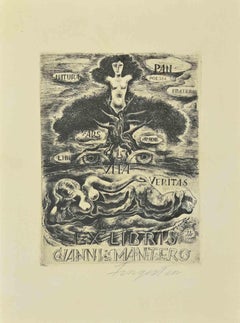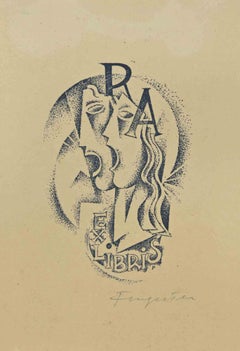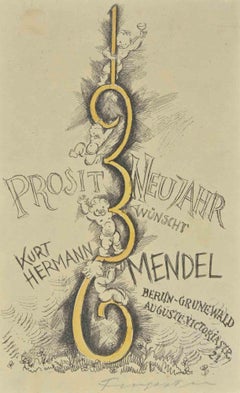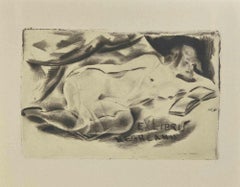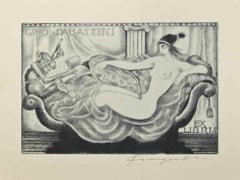Symbolist Art
to
106
572
103
158
44
74
Overall Width
to
Overall Height
to
2
108
640
204
27
103
111
93
13
12
24
18
49
15
114,399
65,080
54,954
27,049
14,917
9,367
6,541
5,778
4,193
3,057
2,584
2,326
2,252
719
604
264
65
566
355
233
182
181
109
101
58
48
48
46
38
33
31
26
25
20
20
20
19
258
224
161
159
134
95
44
38
37
34
132
433
547
248
Style: Symbolist
Ex Libris - Gianni Mantero - Etching by Michel Fingesten - 1930s
Located in Roma, IT
Ex Libris - Gianni Mantero is an Etching print created by Michel Fingesten.
Hand Signed on the lower right margin.
Very Good conditions.
Michel Fingesten (1884 - 1943) was a Czec...
Category
1930s Symbolist Art
Materials
Etching
Ex Libris - Sabattini - Etching by Michel Fingesten - 1930s
Located in Roma, IT
Ex Libris - Sabattini is an Etching print created by Michel Fingesten.
Hand Signed on the lower right margin.
Very Good conditions.
Michel Fingesten (1884 - 1943) was a Czech pai...
Category
1930s Symbolist Art
Materials
Etching
Ex Libris - R. A. - woodcut by Michel Fingesten - 1930s
Located in Roma, IT
Ex Libris - R.A. is a Woodcut print created by Michel Fingesten.
Hand signed on the lower margin.
Good conditions.
Michel Fingesten (1884 - 1943) was a Czech painter and engraver ...
Category
1930s Symbolist Art
Materials
Woodcut
Ex Libris - Kurt Hermann Mendel - Woodcut by Michel Fingesten - 1936
Located in Roma, IT
Ex Libris - Kurt Hermann Mendel is a Woodcut print created by Michel Fingesten in 1936.
Hand signed on the lower margin.
Good conditions.
Michel Fingesten (1884 - 1943) was a Cze...
Category
1930s Symbolist Art
Materials
Woodcut
Ex Libris - Negreanu - Etching by Michel Fingesten - 1930s
Located in Roma, IT
Ex Libris - Negreanu is an Etching print created by Michel Fingesten.
Monogrammed on plate on the right margin.
Good conditions.
Michel Fingesten (1884 - 1943) was a Czech painte...
Category
1930s Symbolist Art
Materials
Etching
Ex Libris - Gino Sabattini - Etching by Michel Fingesten - 1930s
Located in Roma, IT
Ex Libris - Gino Sabattini is an Etching print created by Michel Fingesten.
Hand Signed in the lower right margin.
Good conditions except some foxings that doesn't affect the image...
Category
1930s Symbolist Art
Materials
Etching
Ex Libris - H. Malz Wünscht - Etching by Michel Fingesten - 1936
Located in Roma, IT
Ex Libris - H. Malz Wünscht is a Woodcut print created by Michel Fingesten in 1936.
Hand signed on the lower margin.
Good conditions.
Michel Fingesten (1884 - 1943) was a Czech pa...
Category
1930s Symbolist Art
Materials
Etching
Ex Libris - Violette Talbot - Etching by Michel Fingesten - 1930s
Located in Roma, IT
Ex Libris - Violette Talbot is an Etching print created by Michel Fingesten.
Hand signed on the lower margin.
Good conditions.
Michel Fingesten (1884 - 1943) was a Czech painter ...
Category
1930s Symbolist Art
Materials
Etching
Ex Libris - M.G. Van Wees - Etching by Michel Fingesten - 1930s
Located in Roma, IT
Ex Libris - M.G. Van Wees is an Etching print created by Michel Fingesten in 1940.
Hand signed on the lower margin. Numbered on the left corner, ex. 149/150
Good conditions.
Mich...
Category
1930s Symbolist Art
Materials
Etching
Ex Libris - Gaston Roux - Etching by Michel Fingesten - 1930s
Located in Roma, IT
Ex Libris - Gaston Roux is an Etching print created by Michel Fingesten.
Hand signed on the lower margin.
Good conditions.
Michel Fingesten (1884 - 1943) was a Czech painter and ...
Category
1930s Symbolist Art
Materials
Etching
Ex Libris - Gabriele D'Annunzio - Etching by Michel Fingesten - 1930s
Located in Roma, IT
Ex Libris - Gabriele D'Annunzio is an Etching print created by Michel Fingesten in 1936.
Hand signed on the lower margin.
Good conditions.
Michel Fingesten (1884 - 1943) was a Cz...
Category
1930s Symbolist Art
Materials
Etching
Kuan Yin, Goddess of Compassion, mythical, spiritual, acrylic banner painting.
By Janet Morgan
Located in Brooklyn, NY
Acrylic on theatrical backdrop muslin, can be rolled, rod pockets top and bottom for hanging.
This painting was featured at the Parliament of World Religions in Toronto in 2018. Kuan Yin...
Category
2010s Symbolist Art
Materials
Acrylic, Fabric
Ex Libris W.G.Zwolle - Woodcut - 1940
Located in Roma, IT
Ex Libris W.G.Zwolle is an Artwork realized in 1940.
Woodcut B./W. print on ivory paper. The work is glued on cardboard.
Total dimensions: 20 x 14 cm.
Good conditions.
The artwo...
Category
1940s Symbolist Art
Materials
Woodcut
Ex Libris - Monique Van Paeschen - Woodcut by Linda Ruttelinck - 1982
Located in Roma, IT
Ex Libris - Monique Van Paeschen is a Modern Artwork realized in 1982 s., by Linda Ruttelinck.
B/W woodcut on paper.
The work is glued on grey cardboard.
Total dimensions: 20x...
Category
1980s Symbolist Art
Materials
Woodcut
Ex Libris - Dr. Nicolàs Leòn - Woodcut - Mid 20th Century
Located in Roma, IT
Ex Libris - Dr. Nicolàs Leòn is a Modern Artwork realized in Mid 20th Century
B/W woodcut on paper.
The work is glued on ivory cardboard.
Total dimensions: 21x 14.5 cm.
Exce...
Category
Mid-20th Century Symbolist Art
Materials
Woodcut
Ex Libris - Ibuena Caza! Carlos F Porter - Woodcut - 1949
Located in Roma, IT
Ex Libris - Ibuena Caza! Carlos F Porter is a Modern Artwork realized in 1949.
B/W woodcut on ivory paper.
The work is glued on cardboard.
Total dimensions: 21x 15 cm.
Excelle...
Category
1940s Symbolist Art
Materials
Woodcut
Ex Libris -I. Volders - Woodcut - Mid-20th century
Located in Roma, IT
Ex Libris -I. Volders is a Modern Artwork realized in Mid 20th Century.
B/W woodcut on paper.
The work is glued on cardboard.
Total dimensions: 20x 15 cm.
Excellent conditions...
Category
Mid-20th Century Symbolist Art
Materials
Woodcut
Ex Libris - Esperanza Rufino Tur - Woodcut - 20th Century
Located in Roma, IT
Ex Libris - Esperanza Rufino Tur is a Modern Artwork realized in 20th century .
B/W woodcut on green paper.
The work is glued on cardboard.
Total dimensions: 21x 13 cm.
Excell...
Category
20th Century Symbolist Art
Materials
Woodcut
Ex Libris - Piet Van Veen - Woodcut - Mid 20th Century
Located in Roma, IT
Ex Libris - Piet Van Veen is a Modern Artwork realized in Mid 20th Century
B/W woodcut on ivory paper.
The work is glued on cardboard.
Total dimension...
Category
Mid-20th Century Symbolist Art
Materials
Woodcut
Ex Libris - Dr Enrique Saez - Woodcut - Mid 20th Century
Located in Roma, IT
Ex Libris - Dr Enrique Saez is a Modern Artwork realized in Mid 20th Century
B/W woodcut on paper.
The work is glued on cardboard.
Total dimensions: 21x 15 cm.
Good conditi...
Category
Mid-20th Century Symbolist Art
Materials
Woodcut
Ex Libris - Schult - Woodcut - 1982
Located in Roma, IT
Ex Libris - Schult is a Modern Artwork realized in 1982 s by the graphic artist Zbigniew Józwik (1937).
B/W woodcut on paper. Signed on plate on back
The work is glued on cardboa...
Category
Mid-20th Century Symbolist Art
Materials
Woodcut
Ex Libris - Maria Van Der Meer - Woodcut - Mid-20th century
Located in Roma, IT
Ex Libris -Maria Van Der Meer is a Modern Artwork realized in Mid 20th Century.
Ex Libris. B/W woodcut on paper.
The work is glued on cardboard.
Total dimensions: 20x 14.5 cm.
...
Category
Mid-20th Century Symbolist Art
Materials
Woodcut
Ex Libris -Inter Folia Fructus. G.J.H. Hendriks - Woodcut - Mid-20th century
Located in Roma, IT
Ex Libris -Inter Folia Fructus. G.J.H. Hendriks is a Modern Artwork realized in Mid 20th Century.
Ex Libris. B/W woodcut on ivory paper.
The work is glued on cardboard.
Total d...
Category
Mid-20th Century Symbolist Art
Materials
Woodcut
Ex Libris - N. C. De Jonge - Woodcut by Antonin Dolezal - 1959
Located in Roma, IT
Ex Libris - N. C. De Jonge is a Modern Artwork realized in 1959 s. by the Czech author Antonin Dolezal (20 gennaio 1929)
B/W woodcut on paper. Hand Signed ...
Category
Mid-20th Century Symbolist Art
Materials
Woodcut
Ex Libris - J. G. Beernink - Woodcut - 1932
Located in Roma, IT
Ex Libris - J. G. Beernink is a Modern Artwork realized in 1932 s. by J.G.(Johannes) Beernink (1878-1961)
.
Ex Libris. B/W woodcut on paper.
The work is glued on ivory cardboard....
Category
1930s Symbolist Art
Materials
Woodcut
Ex Libris - Boek Van Corry Zaat - Woodcut - 1934
Located in Roma, IT
Ex Libris - Boek Van Corry Zaat is a Modern Artwork realized in 1934.
Ex Libris. B/W woodcut on paper.
The work is glued on ivory cardboard.
Total dimensions: 20x 14 cm.
Excel...
Category
1930s Symbolist Art
Materials
Woodcut
Ex Libris - Por minha terra. Luiz Ferreira Matias - Woodcut - Mid 20th Century
Located in Roma, IT
Ex Libris - Por minha terra. Luiz Ferreira Matias is a Modern Artwork realized in Mid 20th Century
Ex Libris. Colored woodcut on ivory paper.
The work ...
Category
Mid-20th Century Symbolist Art
Materials
Woodcut
Ex Libris - Adeline De Jonghe - Woodcut - Mid 20th Century
Located in Roma, IT
Ex Libris - Louis Burgers is a Modern Artwork realized in Mid-20th Century.
Ex Libris. B/W woodcut on paper.
The work is glued on grey cardboard.
Total dimensions: 20x 15 cm....
Category
Mid-20th Century Symbolist Art
Materials
Woodcut
Ex Libris Bert-Smit - Woodcut - Mid 20th Century
Located in Roma, IT
Ex Libris Bert-Smit is a Modern Artwork realized in mid 20th Century.
B/W woodcut on paper.
The work is glued on cardboard.
Total dimensions: 20.5 x 14 cm.
Good conditions....
Category
Mid-20th Century Symbolist Art
Materials
Woodcut
Ex Libris Wim Hoogendam - Woodcut - Mid 20th Century
Located in Roma, IT
Ex Libris - Wim Hoogendam is a Modern Artwork realized in mid 20th Century.
B/W woodcut on paper.
The work is glued on cardboard.
Total dimensions: 20 x 15 cm.
Mint condit...
Category
Mid-20th Century Symbolist Art
Materials
Woodcut
Ex Libris Biblioteca Cadeia Comarca de Beja - Woodcut Print - Mid-20th Century
Located in Roma, IT
Ex Libris Biblioteca Cadeia Comarca de Beja is an Artwork, woodcut print on paper. The work is glued on cardboard.
Total dimensions: 21 x 15.5 cm.
The artwork represents an elegan...
Category
Mid-20th Century Symbolist Art
Materials
Woodcut
Ex Libris Imperiosa Fames - Woodcut by Jose Manuel Ballester - Mid-20th Century
Located in Roma, IT
Ex Libris Imperiosa Fames is an Artwork realized by the Spanish Artist, Jose Manuel Ballester
Woodcut print on paper. The work is glued on cardboard.
Total dimensions: 21 x 15 cm...
Category
Mid-20th Century Symbolist Art
Materials
Woodcut
Ex Libris - Wim Rengelink - Woodcut - 1989
Located in Roma, IT
Ex Libris - Wim Rengelink is a Modern Artwork realized in 1989.
B/W woodcut on paper.
The work is glued on cardboard.
Total dimensions: 20x 15 cm.
Excellent conditions .
...
Category
1890s Symbolist Art
Materials
Woodcut
Ex Libris Joan Roig I Montserrat - Woodcut Print - Mid-20th Century
Located in Roma, IT
Ex Libris Joan Roig I Montserrat is a Modern Artwork realized in mid 20th Century.
Ex Libris. B/W woodcut on paper.
The work is glued on cardboard.
Total dimensions: 21 x 1...
Category
Mid-20th Century Symbolist Art
Materials
Woodcut
Ex Libris J. Veroaguer - Woodcut Print - Mid-20th Century
Located in Roma, IT
Ex Libris J. Veroaguer is a Modern Artwork realized in mid 20th Century.
B/W woodcut on paper.
The work is glued on cardboard.
Total dimensions: 21 x 15 cm.
Mint condition...
Category
Mid-20th Century Symbolist Art
Materials
Woodcut
Ex Libris - Woodcut Print - Mid-20th Century
Located in Roma, IT
Ex Libris is a woodcut print on paper. The work is glued on cardboard.
Total dimensions: 20 x 14.5 cm.
The artwork represents a minimalistic, clean design, a abstract shape , throu...
Category
Mid-20th Century Symbolist Art
Materials
Woodcut
Ex Libris Luiz Da Cunha - Woodcut Print - Mid-20th Century
Located in Roma, IT
Ex Libris Luiz Da Cunha is an Artwork, woodcut print on paper. The work is glued on cardboard.
Total dimensions: 21 x 14.7 cm.
The artwork ripresents a minimalistic, clean design, ...
Category
Mid-20th Century Symbolist Art
Materials
Woodcut
Eva's Apples - Woodcut print by Michel Fingesten - 1936
Located in Roma, IT
Eve's Apples is an woodcut realized by Michel Fingesten in 1930s.
Woodcut showing Eve while handing apples. Below a card with number 86 and Fingesten signature.
Includes matte.
...
Category
1930s Symbolist Art
Materials
Woodcut
Identity + The Sum of Parts
Located in Santa Monica, CA
Acrylic, plastic, modeling paste on canvas
Category
21st Century and Contemporary Symbolist Art
Materials
Acrylic
$400 Sale Price
20% Off
La Première Conscience Du Chaos - after Odilon Redon - 1923
By Odilon Redon
Located in Roma, IT
La Première Conscience Du Chaos is a phototype reproduction realized after Odilon Redon.
They belong to the suite "Odilon Redon Peintre, Dessinateur et Graveur", published by Henr...
Category
1920s Symbolist Art
Materials
Photogravure
Ange Déchu - after Odilon Redon - 1923
By Odilon Redon
Located in Roma, IT
Ange Déchu is a prototype reproduction realized after Odilon Redon.
They belong to the suite "Odilon Redon Peintre, Dessinateur et Graveur", published by Henri Felury in 1923.
Tit...
Category
1920s Symbolist Art
Materials
Photogravure
Anémone Humaine Fleurs - Lithograph after Odilon Redon - 1923
By Odilon Redon
Located in Roma, IT
Anémone Humaine Fleurs is a lithograph realized after a watercolor by Odilon Redon.
It belongs to the suite "Odilon Redon Peintre, Dessinateur et Graveur", published by Henri Felur...
Category
1920s Symbolist Art
Materials
Lithograph
Ballerinas - Photolithograph After Constantin Guys - Early 20th Century
Located in Roma, IT
Ballerinas is a photolithograph print on ivory-colored paper, glued on a greenish Passepartout realized in the early 20 century After Constantin Guys
Good conditions.
The critical ...
Category
Early 20th Century Symbolist Art
Materials
Lithograph
Rocket Man, Dungeness, '79 / Howard Jones - Crossed That Line '89 (Album cover)
Located in London, GB
“It was shot on a grey misty day on Dungeness Beach in Sussex. Charlie Wood lit the sky rocket and stood to attention, and I fired the flashgun that was stuffed into his trousers to ...
Category
1970s Symbolist Art
Materials
Glass, Wood, Oak, Photographic Film, Photographic Paper, Black and White...
Figures & Flowers, Surreal Abstract Meditation
By Noel Howard
Located in Soquel, CA
Surreal abstract figurative of a dreamy, meditative scene including multiple figures and flowers, blended with sill-life and landscape elements by Noel Howard (American, 20th Century...
Category
1970s Symbolist Art
Materials
Conté, Crayon, Laid Paper
$680 Sale Price
20% Off
BOSBOOM. 1917.
Located in New York, NY
ROLAND HOLST, R.N. (Richard) (1868-1938). “Eere Tentoonstelling Bosboom/ 1817 1917/ Pulchri-Studio ‘s Gravenhage/ 21 Apr[il] 31 Mei”. Color lithograph (pa...
Category
1910s Symbolist Art
Materials
Lithograph
Ex Libris PF - Woodcut by Michel Fingesten - 1936
Located in Roma, IT
Ex Libris PF is a woodcut print by Michel Fingesten, realized in 1936.
Hand signed, included a white cardboard passpartout (30x24 cm).
In excellent conditions: As good as new.
Michel Fingesten (1884 - 1943) was a Czech painter and engraver of Jewish origin. He is considered one of the greatest Ex Libris artists in history. From an Austrian weaver father and a Jewish mother...
Category
Early 20th Century Symbolist Art
Materials
Woodcut
Ex Libris Gigi Raimondo - Etching by Michel Fingesten - 1937
Located in Roma, IT
Ex Libris Gigi Raimondo is an Etching by Michel Fingesten, in 1937.
Hand signed with pencil, included a white cardboard passpartout (30x24 cm).
In excellent conditions: As good as new.
Michel Fingesten (1884 - 1943) was a Czech painter and engraver of Jewish origin. He is considered one of the greatest Ex Libris artists in history. From an Austrian weaver father and a Jewish mother from Trieste. At 16 he studied at the Vienna Academy, together with Oskar Kokoschka. From 1902 to 1906 he wandered around America, and then Australia, before arriving in Palermo in 1907. He went up the peninsula via Trieste and returning to Germany, first settling in Munich in Franz von Stuck's studio, practicing caricature and small format graphics and then in Berlin.
In 1913 he began to record. He returned to Italy in 1935 to visit his maternal relatives from Trieste and remained there because of the racial persecutions to which the Jews in Silesia were subject, settling in Milan. In this period he recorded about 500 exlibris. On 9 October 1940 he was arrested and interned as a foreigner in the camp of Civitella del Tronto and then of Ferramonti, (Cosenza) from November 1941 and will be accused by the Nazis of having painted degenerate art...
Category
Early 20th Century Symbolist Art
Materials
Etching
Ex Libris G.B. - Woodcut by Michel Fingesten - 1937
Located in Roma, IT
Ex Libris G.B. is a woodcut print by Michel Fingesten, in 1937.
Hand signed , included a white cardboard passpartout (30x24 cm).
In excellent conditions: As good as new.
Michel Fingesten (1884 - 1943) was a Czech painter and engraver of Jewish origin. He is considered one of the greatest Ex Libris artists in history. From an Austrian weaver father and a Jewish mother from Trieste. At 16 he studied at the Vienna Academy, together with Oskar Kokoschka. From 1902 to 1906 he wandered around America, and then Australia, before arriving in Palermo in 1907. He went up the peninsula via Trieste and returning to Germany, first settling in Munich in Franz von Stuck's studio, practicing caricature and small format graphics and then in Berlin.
In 1913 he began to record. He returned to Italy in 1935 to visit his maternal relatives from Trieste and remained there because of the racial persecutions to which the Jews in Silesia were subject, settling in Milan. In this period he recorded about 500 exlibris. On 9 October 1940 he was arrested and interned as a foreigner in the camp of Civitella del Tronto and then of Ferramonti, (Cosenza) from November 1941 and will be accused by the Nazis of having painted degenerate art ("Entartete Kunst...
Category
Early 20th Century Symbolist Art
Materials
Woodcut
Art Déco Painting, ca. 1910, oil on cardboard. Romantic love scene in the forest
Located in Berlin, DE
Painting, around 1910, oil on cardboard. Romantic love scene in the forest.
Signed, Gaston Bussiere.
With beautiful (original) Art Deco frame.
Frame has minimal damage in places.
Dimensions with frame 67cm x 86cm
This painting is offered here for the first time exclusively on 1stdibs!
From private, German estate.
Gaston Bussière (April 24, 1862 in Cuisery – October 29, 1928 or 1929 in Saulieu) was a French Symbolist painter and illustrator.
Bussière studied at l'Académie des Beaux-Arts in Lyon before entering the école des beaux-arts de Paris where he studied under Alexandre Cabanel and Pierre Puvis de Chavannes. In 1884, he won the Marie Bashkirtseff...
Category
1910s Symbolist Art
Materials
Oil, Panel, Cardboard
$25,153 Sale Price
25% Off
Sad Hour - Original Etching by Attilio Zanchelli - Early 20th Century
Located in Roma, IT
Sad Hour is an Original Etching realized by Attilio Zanchelli.
The artwork is in good condition, included a cardboard passpartout (32x50 cm).
Edition of 20.
Attilio Zanchelli (186...
Category
1880s Symbolist Art
Materials
Etching
Deutsches Dichterjubilaum - Rare Book Illustrated by Hans Steiner - 1923
Located in Roma, IT
Deutsches Dichterjubilaum is a book written by Arno Holz (1863 – 1929) and illustrated by Hans Steiner (1907-1962) and in 1923.
Original First Edition.
Published by Werkverlag, Be...
Category
1920s Symbolist Art
Materials
Paper, Photogravure
Ex Libris Naclowski - Woodcut Print - Early 20th Century
Located in Roma, IT
Ex Libris Naclowski is an original Contemporary Artwork realized in the early 20th Century.
Original B/W woodcut print on ivory-colored paper.
The work is glued on cardboard.
...
Category
Early 20th Century Symbolist Art
Materials
Woodcut
Ex Libris Cseh Lajos Konive - Original Woodcut Print - Early 20th Century
Located in Roma, IT
Ex Libris Cseh Lajos Konive is an original Modern Artwork realized in the 20t Century.
Original B/W woodcut print on ivory-colored paper.
The work is glued on cardboard.
Total ...
Category
Early 20th Century Symbolist Art
Materials
Woodcut
Ex Libris - Cross - Original Woodcut by Michel Fingesten - Early 20th Century
Located in Roma, IT
"Ex Libris - Cross" is an original woodcut on paper realized by Michel Fingesten, Early 20th Century. Hand signed and with hand notes in pencil on the lower.
In good conditions, exce...
Category
Early 20th Century Symbolist Art
Materials
Woodcut
Ex Libris RS - Woodcut by Michel Fingesten - Early 20th Century
Located in Roma, IT
"Ex Libris RS" is an original woodcut artwork on creamy paper by Michel Fingesten, Early 20th Century.
Hand-signed on the lower right and with notes in pencil.
In excellent conditio...
Category
Early 20th Century Symbolist Art
Materials
Woodcut
Portrait of Stefan George - Woodcut by Reinhold Lepsius- Early 1900
Located in Roma, IT
"Portrait of Stefan George" is an original woodcut on brown-colored paper, realized by Reinhold Lepsius (1857-1922).
The state of preservation of the ar...
Category
Early 20th Century Symbolist Art
Materials
Woodcut
Meeting - Original Photogravure by Constantine Guys - 1850s
Located in Roma, IT
Meeting is a wonderful original print on brownish paper, realized by the French artist, Constantin Guys (1802 -1892).
In very good condition, including a pet...
Category
1850s Symbolist Art
Materials
Photogravure
$209 Sale Price
30% Off
Figures - Pencil on Brownish Paper - 20th Century
Located in Roma, IT
Figures is an original drawing in pencil on brownish paper realized by an Anonymous artist of the XX century.
With the drawing on the rear.
With the stamp on the lower right" Mouli...
Category
20th Century Symbolist Art
Materials
Pencil
Auferstehung - Héliogravure by Franz von Bayros - 1920s
Located in Roma, IT
"Auferstehung" is an original Black and white héliogravure on cream-colored cardboard realized by Choisy Le Conin, pseudonym of Franz Von Bayros (Agram, 1866 – Vienna, 1924).
From M...
Category
1920s Symbolist Art
Materials
Engraving
Symbolist art for sale on 1stDibs.
Find a wide variety of authentic Symbolist art available for sale on 1stDibs. Works in this style were very popular during the 21st Century and Contemporary, but contemporary artists have continued to produce works inspired by this movement. If you’re looking to add art created in this style to introduce contrast in an otherwise neutral space in your home, the works available on 1stDibs include elements of orange, blue, green, red and other colors. Many Pop art paintings were created by popular artists on 1stDibs, including Michel Fingesten, Abel Pann, Franz von Bayros (Choisi Le Conin), and Ferdinand Hodler & R. Piper & Co.. Frequently made by artists working with Paint, and Oil Paint and other materials, all of these pieces for sale are unique and have attracted attention over the years. Not every interior allows for large Symbolist art, so small editions measuring 1.58 inches across are also available. Prices for art made by famous or emerging artists can differ depending on medium, time period and other attributes. On 1stDibs, the price for these items starts at $55 and tops out at $378,675, while the average work sells for $863.
Still Thinking About These?
All Recently ViewedMore Ways To Browse
Mauritz Lindstrom
Maximillien Luce
Michael Budden Central Park
Midcentury Matador Paintings
Mike Wright
Miracle On Ice
Mississippi River Painting
Monarch Of The Glen Painting
Moroccan Paintings Essaouira
Morpho Butterfly Art
Mount Tamalpais
Murray Dessner
Native American Oklahoma
New England Barn
New Orleans Jazz Poster
Niagara Falls Oil
Oil Painting By Alice
Oil Painting Willow Tree
